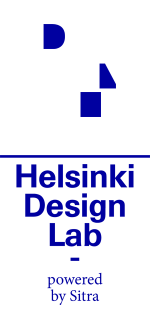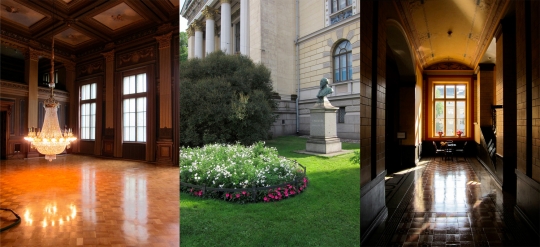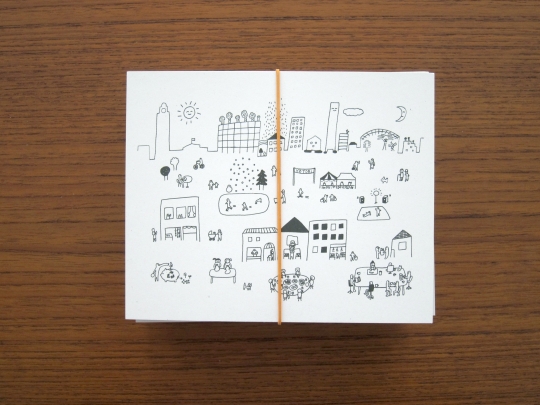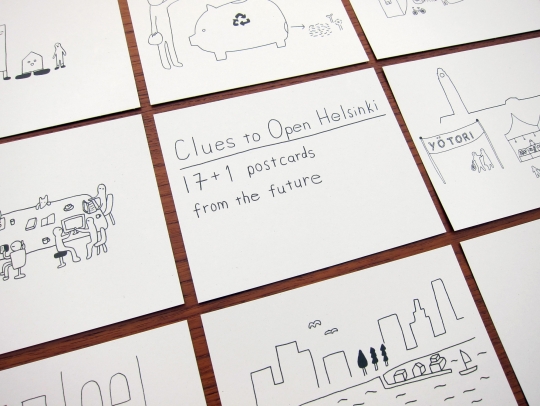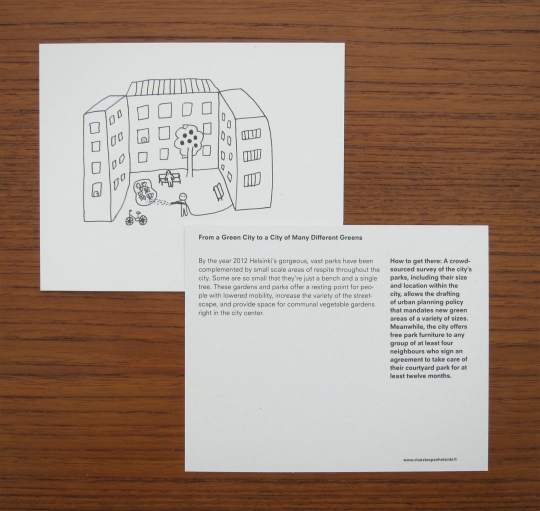Helsinki Design Lab helps government leaders see the "architecture of problems." We assist decision-makers to view challenges from a big-picture perspective, and provide guidance toward more complete solutions that consider all aspects of a problem. Our mission is to advance this way of working—we call it strategic design.
This week at HDL we began doing things labeled "final." Final venue visits, final guests lists, final head counts, final prep meetings. This is appropriate with HDL Global now less than 10 days away.
In anticipation of panel discussions which will use the HDL Studios as starting points, we wanted to share some of the outcomes of the Studios... but how do you present something that is in flux, under development? The format we've developed is called the HDL Dossiers. Go check it out—and if you like, you can read below as I share a bit of the thinking behind this format.
A slightly nerdy introduction to the HDL Dossiers
If your process is non-linear, as the design process often is, forcing yourself to use a linear tool is counter productive. Since most blogs and other content management tools are rigidly linear, we needed a new tool to support the work of HDL. We needed a new way to see our work.
The ease of use that a blog allows, as a simple long list of stuff, is great. But its not designed for content that is evolving. We wanted a format that would enable us to evolve a presentation of information and ideas as our understanding develops and changes. One of the important aspects of this is the ability to have control over how bits of information are located. Does A need to sit next to B to make sense? With a normal blog you don't have control over that. The best you can do is to post things in chronological order.

A blog lets you add content to the top of the pile but our Dossiers tool lets us add new stuff while also continually re-shuffling the pile.
We needed the ease of use of a blog, where content is stored in a database and easily manipulated, with the flexibility of a sketchpad, where the presentation is freeform and maleable. And since this is a tool that we intend to use in the daily course of HDL's work, it needs to have a sense of history as well. It needed to be able to keep track of time by allowing versions which the user can then "scrub" back and forth between.
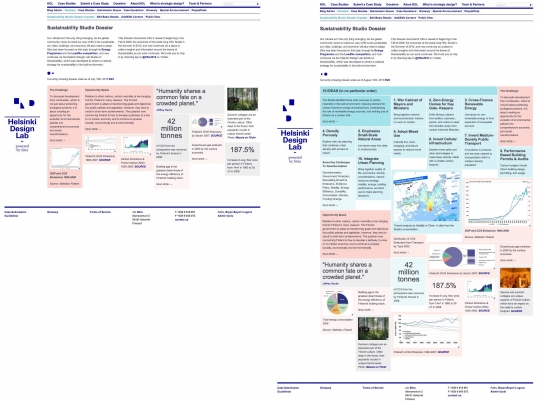
The Sustainability Dossier evolving through time.
The result is something like this. Here's an image of the Sustainability Dossier in two different states. The left shows what it looked like before the studio. In that state we've just assembled the bones of the challenge briefing. But on the right the studio has concluded and their recommendations are starting to filter into the mix. Between the versions some information becomes less important (and thus smaller) or disappears altogether because it's no longer important.
It was a squeeze to get this work done with our already-ambitious HDL Global preparations, but I'm glad we did because we are finally reflecting a bit of work from the Studios. I hope you enjoy digging around the Dossiers and please direct any tips to @HDL2010 or the contact form on this site. We'd love to hear from you.
Leading up to HDL Global 2010 we've been digging into the HDL archives and talking to some of the organizers of the event in the 1960s that has grown up to become part of the Helsinki Design Lab initiative.
Jaakko Ihamuotila spent decades running Neste and Fortum, two of Finland's largest corporations, but as a young student he was one of the organizers, together with Juhani Pallasmaa and three others, of HDL Global 1968.
Jaakko kindly sat with me in his home for this video interview discussing his role as one of the organizers of Teollisuus Ympäristö Tuotesuunnittelu (Helsinki Design Lab Global 1968), and in particular the value of design when exploring new areas of knowledge.
For once I'm getting to the weeknote during the actual week itself. To start, a recap of some new things here in case you missed them.
The first of three interviews is now online. We started off the series with Juhani Pallasmaa recounting his experience at HDL Global 1968. Next week we'll have an interview with Jaakko Ihamuotila and ending with Yrjö Sotomaa the week after that. In the meantime, you can have a look at the Clues to Open Helsinki, a quick project Sitra did with OK Do to get the brain juices flowing in advance of Helsinki's World Design Capital year in 2012. One bit looking backwards and one looking forwards. We like balance.
This week was more of the same with regards to HDL Global: catering, AV, venues, transport, logistics. We've taken to joking about being wedding planners. Government, do you promise to love and care for design, in sickness and in health?
As part of the event we will be hosting conversations around each of the studio themes. This is an opportunity to leverage the work of our HDL Studios to frame a conversation about the globally relevant themes of ageing, education, and sustainability with particular attention to facets where strategic design may have a role. To kick off these sessions we've created video recaps of the three Studios. Those videos will be posted here after they premiere at the event.

Screens from the Sustainability Studio recap video
It feels very good to have these three videos done. Not only was it a significant and hectic effort on the behalf of Seungho and I, but they're also our first foray into using video to explain our work. We've wanted to do this for a long time and the biggest outcome of the past two weeks is a reminder that sometimes you just have to force yourself into new territory rather than waiting for the calendar to magically clear itself up.
If you're doing your first video project while organizing your first major event, why not also throw in the first piece of HDL software? One of the difficulties we've been struggling with since the very start of the challenge briefing work is a way to organize research around fuzzy topics. Most of the research and info gathering we're engaged in comes into focus over a relatively long period of time, and we're often fickle when it comes to categorizing, arranging, weighting, and editing our sources. We like to test out different editorial decisions—arguments, ultimately—quickly and often.
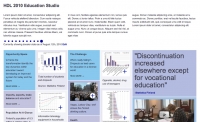
The Dossier tool is still under development
Unable to find the right tool on the market, we decided to build one for internal use. We needed something more accessible than a raw database of content and with the possibility for more articulate relationships than a typical reverse-chronology blog. After experimentation with just about every knowledge management tool we could find, nothing felt right. Instead, we've been working with XOXCO to build the HDL Dossier tool, which is at it's core a 2-dimensional blog. If your average blog is a linear list of diverse content, we've created a place to keep bits of information organized in 2 dimensions, therefore allowing for more specific relationships to be built up between the bits. We'll have some more thoughts on this when it goes live. Next week, hopefully!
So it goes.
From time to time we check in on other Sitra projects such as Low2No and today we're happy to announce something new.
Last November Helsinki edged out Eindhoven to win the status of World Design Capital for 2012. This is a big thing for our small city and it has spurred many conversations about what should, could, might, and hopefully will happen. Everyone here is anxious to have the world come see what design means to Helsinki.
We're especially happy to be helping Helsinki's World Design Capital foundation imagine new roles for design within the public sector and there will surely be more to talk about on that front as our collaboration evolves. But in the meantime...
To get our minds working we teamed up with OK Do for a quick project speculating on the hows that could enable the many good ideas already flowing around town. This became Clues for Open Helsinki: a pack of 17+1 postcards from the near future.
Each card features a nice idea (illustrated by Nene Tsuboi) and a set of speculative suggestions for how the city might use everything at its disposal to enable activity in this area.
We're interested in 2012 becoming the year that structural tools such as laws, taxes, permits, leases, financing, and metrics become part of the global design discourse. In other words, we'd like to see designers more actively involved in—and engaged—by strategic decisions and Clues to Open Helsinki is a small step in that direction.
In addition to being a prolific author, Juhani Pallasmaa is one of Finland's most prominent living architects and he also happens to have been one of the organizers of HDL Global 1968. In this video interview, Marco Steinberg met with Juhani in his home to talk about the state of the world and design's role in the 1960s and 1970s.
As we near HDL Global 2010, it's fascinating to look back at these historical roots and see how things have both changed immensely and stayed the same. Next wednesday have another interview coming up, this time featuring Jaakko Ihamuotila.
If this was any indication of what we can expect for the whole of August, it's going to be a crazy month as we narrow in on HDL Global. Lots of things cooking right now—probably too many.
XOXCO are nearing completion on the HDL Dossiers, a new part of this site which will help us keep track of our focus areas in a new and exciting way. That should launch in another week or two, depending on whether we send them timely feedback or not.
Seungho has been drawing like a madman as he finishes up the artwork for a series of animations that Eetu and I are putting into motion. As I type this, one of nine animation sequences is rendering in the background.
We've also started sending things to press. This week was 14 A-frame signs to be used in our venues. Next week we will be sending badges and other bits. From now until September 1st there are deadlines every few days so it's marathon mode.
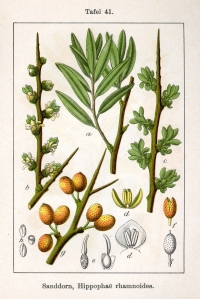
Sea Buckthorn berries are tasty
Tomorrow: catering decisions. Have you ever had a Sea Buckthorn Berry? They're delicious, good for you, and plentiful here in Finland. Highly recommended.
Speaking of food, Kigge, Liza, and Adam from INDEX stopped by for lunch while there were in town on other matters. It was nice to catch up and to hear about the Designing for Education student challenge they've just launched.
Everything else is proceeding as usual. The whole team is finally back from summer holidays and things are moving quickly. This week was tiring but good, a formula that we're anticipating a lot of in our near future.
Emil + Stephanie are developing the visual identity for HDL Global 2010 as something that's more dynamic than a logo and less rigid than a system. The approach is to create a mood in the imagery that hints at a broad territory of possibilities as we invite our event guests to explore new territories in leadership, decision-making, and strategic redesign. The material prominently features a photo illustration (seen here if you scroll down) which was created in a frenzied weekend of creativity. It looked something like this:
This kicks off a month of films for HDL. Each wednesday between now and the end of August we'll post a short film. Following this are a series of three interviews with some of the people who organized HDL Global 1968.
Things were already picking up in the Sitra offices this week as people begin to trickle back from summer holidays. We were occupied with a full checkup of our operational plans for September. This was a pragmatic follow up to last week's review of all HDL Global 2010 content.
Over a long lunch Marco and I looked at the calendar week by week through August, and then day by day in the final week leading up to the event. There are a lot of loose ends to tie up in the next month, but it's coming together pretty well.
Meanwhile, the OCR experiment we began last week is coming along. Rory Hyde deserves a kind shout out for his contribution of five pages of OCR work. Would you care to OCR a page or two?
And we also have something nice to look at. This sneak preview of what HDL Global 2010 looks like is from Emil+Stephanie:
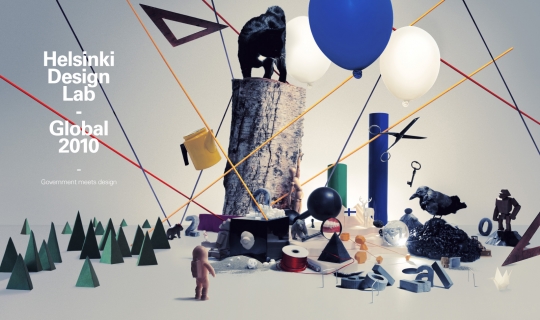
On Wednesday we'll also post a very short little film about how this picture came to be.
As the quiet month of July comes to a close, we're savoring these last moments of relative calm. This morning began with a thunderstorm in Helsinki—a sign?
We've been re-working the programme for HDL Global yet again—it's subject to constant tweaks as we fine tune the flow and punctuation. Marco has taken to keeping the programme schedule as a constantly-open document on his computer and from time to time we open that window and twiddle bits around. Should Talk A come before talk B? As we've witnessed while attending other events, getting the order of the day right makes a big difference. Get the sequence wrong and you lose momentum, but if the programme unfolds properly ideas will be humming by the end of the day.

A salmiakki tasting at Emil+Stephanie's office as we curate a welcome pack for our international guests.
Various other bits: on the horn with Eric in San Francisco, Cecilia in Singapore, and Bill in Cambridge, MA; meeting with Emil+Stephanie to review print design work; had a prep meeting with Eetu, who will be helping with some video editing next week; and started thinking through alternative scenarios for all three days of the event. What happens if Person X misses their flight? That sort of thing.
We also began uploading transcripts from HDL Global 1968 to our Flickr account. If you're a fan of Christopher Alexander's work you may enjoy his presentation of "The Organization of Design Pattern." I thought it might be interesting to try an experiment in crowdsourced OCR. I've transcribed the first page of Alexander text, maybe you would like to contribute by OCRing another page?
Last week was supposed to be a slow one, but two meetings fell into place at the last minute and so the HDL team (those of us not enjoying the Finnish summer) was split between Zurich, Moscow, and Helsinki. It was a time for us to focus our thoughts some long term ideas about what HDL is and could be—an exciting thing for us to be thinking through.

A snapshot from our whirlwind trip to Zurich
One of the biggest questions on our minds has been, "what next?" We have a clear idea of where HDL goes, but on a broader sense we're interested—maybe even concerned about—the hype that has been recently poured into the term "design." The danger is that the hype becomes destructive if the design community is not able to deliver. So far, many corners of the business world have been convinced of the importance of designers involved in many different, and more strategic roles, but what about NGOs, cities, or even nations? Although early evidence from that sphere is positive, as one can see in our case studies and elsewhere, the available pool of successes is small.
Which makes us curious: what should HDL do to grow that pool? What's the right role for design within larger organizations? How much design "presence" is necessary, or even wanted? Our own Studios are one proposition, but we're anxious to see more happening, and more quickly.
How will strategic design engagements be funded and by who? If one of the defining factors of truly strategic work is that it cuts holistically across silos, it might always be difficult to find funding. At the end of the day, the majority of the world operates under the cruel logic of the budgetary line item, so how can strategic designers find a place to fit when their work is naturally between the lines?
This is a true design problem in every sense of the word.
